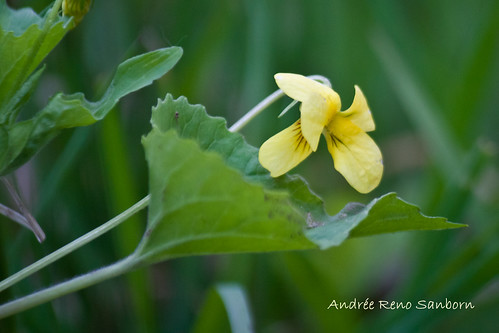downy yellow violet
(Viola pubescens)
Conservation • Wetland • Description • Habitat • Ecology • Use • Distribution • Taxonomy
Description |
Downy yellow violetrises on one or two stems. There are usually no basal leaves, sometimes there is just a single basal leaf. The leaf blades are egg-shaped to kidney-shaped and have a broadly angled to straight (truncate) base. The upper and lower leaf surfaces are densely covered with minute, fine, short hairs, especially along the main veins. The leaf margin has 15 to 23 teeth per side. The upper leaf stipules are herbaceous, broadly egg-shaped, and broadly angled at the tip. The flowering stem is conspicuously hairy. |
Height |
|
Flower Color |
Yellow |
Similar Species |
Smooth yellow violet (Viola eriocarpa) rises on usually three or more stems. There are usually 1 to 4 basal leaves. The leaf blades are heart-shaped to broadly egg-shaped and have a heart-shaped base. The upper and lower leaf surfaces are hairless or sparsely hairy. The leaf blade has 8 to 15 teeth per side. The upper leaf stipules are semi-herbaceous, lance-shaped, and narrowly angled at the tip. The flowering stem is hairless or has hairs in longitudinal lines. Smooth yellow violet is much more widespread and much more common. |
Habitat |
Dry. Woods, forests. |
Ecology |
Flowering |
April to June |
Pests and Diseases |
|
Use |
|
Distribution |
||
|
Sources |
|
| 5/9/2025 | ||
Nativity |
||
Native |
||
Occurrence |
||
|
||
Taxonomy |
|
Kingdom |
|
| Division |
Tracheophyta (Vascular Plants) |
Subdivision |
Spermatophytina (Seed Plants) |
Class |
|
Order |
Malpighiales (Nances, Willows, and Allies) |
Family |
Violaceae (violet) |
Subfamily |
Violoideae |
Tribe |
Violeae |
Genus |
Viola (violets) |
Subgenus |
Viola (pansies and violets) |
Section |
Chamaemelanium |
Subsection |
|
A survey of violets (Russel, 1965) argued that Viola pubescens and Viola eriocarpa intergraded wherever the two species occurred together. For this reason, he combined them as subspecies, and he renamed Viola eriocarpa to Viola pubescens var. eriocarpa. Following that publication, virtually all floras and treatments used the name Viola pubescens var. scabriuscula. Several treatments between 1995 and 2001 synonymized the two species as Viola pubescens. A recent taxonomic treatment of the genus Viola reviewed just the species occurring in northeastern North America, specifically those species included in the second edition of Gleason and Cronquist’s Manual of Vascular Plants of Northeastern United States and Adjacent Canada. Among the many changes suggested by the authors was separating Viola pubescens var. pubescens and Viola pubescens var. scabriuscula as distinct species. |
|
Subordinate Taxa |
|
|
|
Synonyms |
|
Viola pubescens var. pubescens |
|
Common Names |
|
downy yellow violet |
|
Glossary
Rhizome
A horizontal, usually underground stem. It serves as a reproductive structure, producing roots below and shoots above at the nodes.
Visitor Photos |
||
Share your photo of this plant. |
||
This button not working for you? |
||
|
||
|
||
MinnesotaSeasons.com Photos |
||
 |
||
Plant |
||
 |
 |
|
Flower |
||
 |
 |
|
Leaves |
Stipule | |

Slideshows |
Downy Yellow Violet |

|
About
Copyright DianesDigitals |
Downy Yellow Violet (Viola pubescens) |

|
About
Copyright DianesDigitals |

Visitor Videos |
||
Share your video of this plant. |
||
This button not working for you? |
||
|
Other Videos |
||
|

Visitor Sightings |
||
Report a sighting of this plant. |
||
This button not working for you? |
||
|
|
MinnesotaSeasons.com Sightings |
||

|
Created: Last Updated: © MinnesotaSeasons.com. All rights reserved. |
